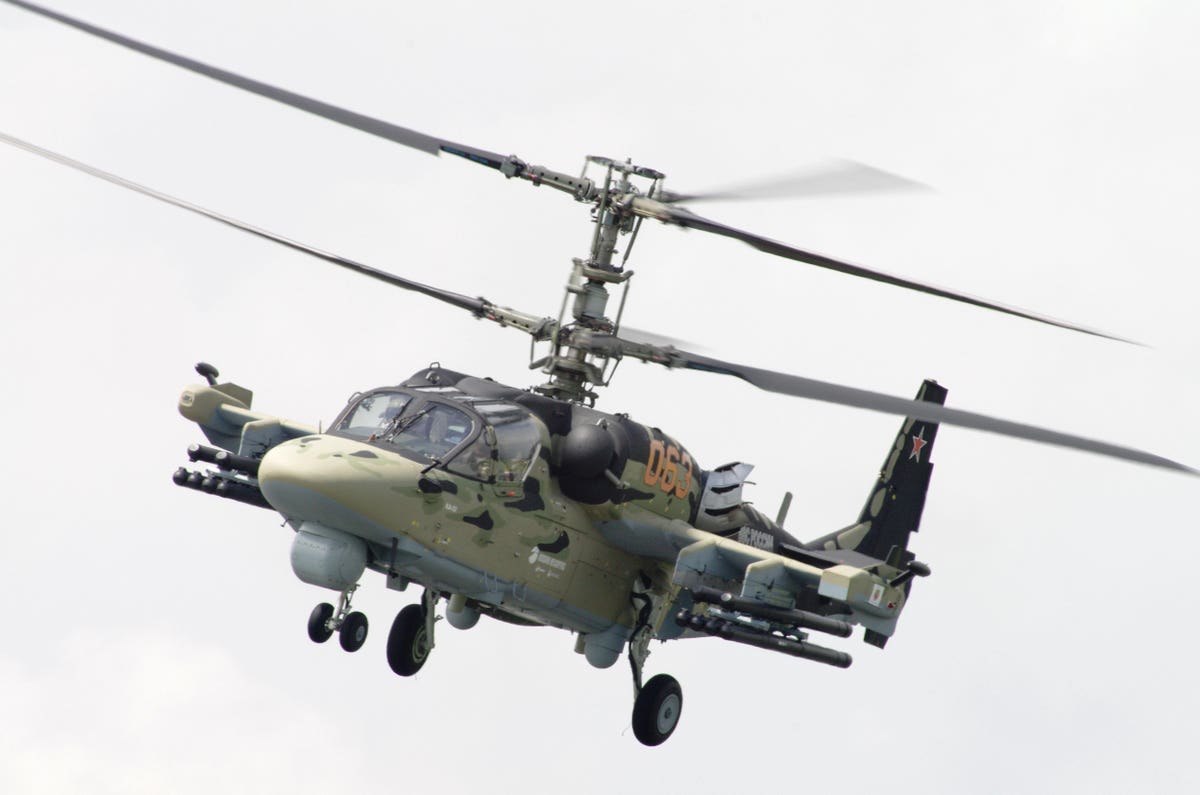As Ukrainian force battle through belts of defensive minefields, anti-tank ditches and concrete dragon’s teeth, Russian forces are hitting back with attack helicopters armed with a new and highly effective missile able to strike at long range.
“One of the single most influential Russian weapon systems in the sector is the Ka-52 HOKUM attack helicopter,” noted the Intelligence Update issued by the U.K.’s Ministry of Defence on Thursday, observing these are the new KA-52M variant developed from combat experience in Syria. The KA-52M is claimed to have a modernized electro-optical targeting turret, advanced communications and a stores management system which allow it to carry new types of weapons, including a notably deadly missile.
“Another key improvement to the Ka-52 fleet is the integration of a new anti-tank missile,” the MoD Update continues. “The LMUR, which has a range of approximately 15km. Ka-52 crews have been quick to exploit opportunities to launch these weapons beyond the range of Ukrainian air defences.”
This represents a real escalation in helicopter capabilities. Russian helicopters like the Ka-52 are designed for the anti-tank role with laser-guided Vikhr and ATAKA anti-tank guided missiles (ATGM), with ranges of around 10 km and 6 km, respectively. However, these missiles require line-of-sight with the target and the limited range tends to bring the helicopter dangerously close to Ukraine’s air defenses, such as U.S. supplied Stinger shoulder-launched missiles and the Starstreak from the U.K.
This is why most attack helicopters on both sides have been limited to rocket lofting attacks in which the helicopter flies close to the ground then angles sharply upwards to launch volleys of unguided rockets towards enemy positions before turning away. They are highly inaccurate, but lobbing rockets in this way does not expose the helicopter to enemy fire.
LMUR is in a different league. Technically known as the Izdeliye Product 305, the name LMUR is from Lyogkaya Mnogotselevaya Upravlayemaya Raketa (“Lightweight Multipurpose Guided Missile”). The weapon was first revealed in 2007, with testing starting in 2015 and production after 2016. ‘Lightweight’ is something of a misnomer, as it weighs over 200 pounds, twice as much as the Vihkr missile and six times as much as ATAKA.
Rather than relying on laser guidance, the LMUR uses a combination of thermal imaging and satellite navigation. In the direct-fire mode, the operator locks the thermal seeker on to a target and fires (a similar system to the U.S. Javelin portable anti-tank missile). For longer-range encounters though, the operator can fire the missile from out of sight towards specified co-ordinates, then use the missile’s thermal imager to find and lock on to the target.
As Stijn Mitzer of defense analysts Oryx notes in an article on the LMUR, the type was first seen in Ukraine in June last year when one struck a building, likely from an Mi-28 helicopter. Subsequent strikes also seem to have been confined to buildings identified as high-value targets. Their target identification is questionable though – the Russian Ministry of Defense released one LMUR video claimed to show it hitting a building housing two HIMARS vehicles – they did not explain how the vehicles were driven to the second story where the missile was aimed.
Before the counter-offensive, Oryx noted LMUR strikes on 43 buildings, 6 bridges, 2 trucks and 5 armored vehicles. Now that the missiles have been paired with the highly capable Ka-52 attack helicopter they are being used in their intended anti-tank role.
NATO and in particular the U.S. Army developed the concept of anti-tank helicopters in the Cold War. Their mobility and ability to strike from stand-off distances makes them ideal for meeting armored offensives, as they can quickly be rushed to the site of any potential breakthrough to blunt the attack. And in Ukraine it seems to be working.
Rolling out the new Ka-52M with LMURs suggests they are throwing everything they have into slowing the Ukrainian offensive. At a cost of over $220k per missile, the LMUR is in short supply and only 200-300 were purchased, according to some estimates.
What the Ukrainians need are more air defenses with long reach like Patriot, or other capabilities (such as those F-16s, or long-range weapons to hit Russian airbases) to tackle the threat posed by Russian helicopters with LMURs. Without them the progress of the offensive is likely to be slow and bloody.
Read the full article here





